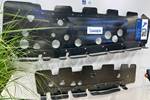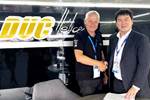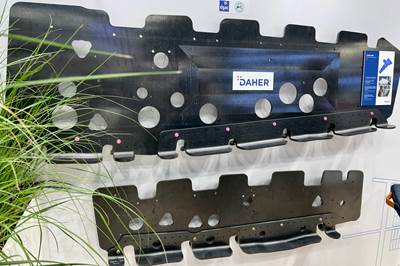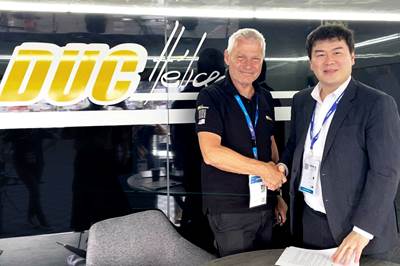Daher delivers first new-production Kodiak 100 aircraft
North Carolina’s Forest Services have received Daher’s Kodiak 100 multi-mission aircraft equipped with Hartzell’s five-blade composite propeller.
Daher (Nantes, France) has delivered a turboprop-powered Kodiak 100 to the North Carolina Forest Service’s Aviation Division (Raleigh), which becomes a new customer as well as the initial operator of this multi-mission aircraft equipped with a composite five-blade propeller. The North Carolina Forest Service will use its Kodiak 100 as a “load aircraft," which carries equipment and supplies to operational locations in support of aerial tankers in the wildfire suppression role.
This is Daher’s first new-production Kodiak 100 to be delivered with the composite five-blade propeller configuration from Hartzell Propeller (Piqua, Ohio, U.S.), enhancing the aircraft’s performance and further improving its sustainability.
“As North Carolina’s motto is: ‘First in Flight,’ it’s appropriate that the state’s Forest Service is the initial operator of this latest upgrade for the Kodiak 100,” says Nicolas Chabbert, the senior vice president of Daher’s Aircraft Division.
Tailored specifically for use on the Kodiak 100, the new five-blade propeller incorporates Hartzell’s lightweight Raptor propeller hub technology. The entire unit weighs 13 pounds less than the Kodiak 100’s current four-blade metal propeller, and reduces the aircraft’s takeoff roll by 6% at maximum gross weight. The propeller is durable by design, with a time between overhaul (TBO) of 4,000 hours/six years, and a warranty of six years or up to 4,000 hours. At a diameter of 96 inches, the five-blade composite propeller has a ground clearance of 16.4 inches, retaining the Kodiak 100’s ability to operate from unprepared strips and in the amphibious version when equipped with floats.
Of the total 320-plus Kodiak 100s delivered to date, more than 90 are in service with multi-mission operators.
In addition, the propeller is reported to be 6.6 decibals quieter than the metal propeller Kodiak 100s typically use, turning at 2,000 rpm for maximum torque — 200 rpm slower than the current four-blade metal propeller. This slower rotation speed also reduces vibration aboard the aircraft and lowers the Kodiak 100’s flyover noise below the European Union Safety Agency (EASA) airworthiness authority’s stringent 78 A-weighted decibal requirement.
New-production Kodiak 100 Series III aircraft are now available with the five-blade composite propeller as an option. The retrofit for all in-service Kodiak 100s is offered via the Hartzell Top Prop program.
“We welcome the Kodiak 100 to the family of aircraft equipped with our five-blade composite propeller, joining Daher’s Kodiak 900 and the TBM 960,” Hartzell President JJ Frigge says. “Hartzell has been producing composite blades since 1978, which are made with a structural carbon fiber that offers superior strength, damage resistance and reparability.”
Key features of Hartzell’s composite propeller blades include a durable nickel-cobalt leading edge, a nickel erosion screen for foreign object damage (FOD) protection, urethane paint for improved erosion protection and the use of aerospace-grade carbon fiber.
Daher’s Kodiak 100 is a multi-mission workhorse, operated worldwide in applications that range from wildfire suppression, the monitoring of national resources and the protection of public safety to humanitarian services and intelligence, surveillance and reconnaissance (ISR) duties. Of the total 320-plus Kodiak 100s delivered to date, more than 90 are in service with multi-mission operators, logging an estimated 28,500 flight hours annually for this fleet segment.
“With its useful load, off-airport capabilities, simple and rugged design, the Kodiak 100 is ideal for such a broad range of applications,” Paul Carelli, the director of Kodiak flight operations and special missions, emphasizes. “In addition to the performance improvement with Hartzell’s five-blade composite propeller, the aircraft is extremely quiet. This is significant for missions such as forestry and law enforcement, and also is important when flying recreationally in backcountry environments.”
Hartzell’s composite propellers have advanced aircraft such as Eviation Aircraft’s Alice, Epic Aircraft’s E1000 GX, the Cubcrafter aircraft, Universal Hydrogen’s Dash 8 and are enabling further lightweighting for advanced air mobility (AAM).
Related Content
Plant tour: Spirit AeroSystems, Belfast, Northern Ireland, U.K.
Purpose-built facility employs resin transfer infusion (RTI) and assembly technology to manufacture today’s composite A220 wings, and prepares for future new programs and production ramp-ups.
Read MoreInfinite Composites: Type V tanks for space, hydrogen, automotive and more
After a decade of proving its linerless, weight-saving composite tanks with NASA and more than 30 aerospace companies, this CryoSphere pioneer is scaling for growth in commercial space and sustainable transportation on Earth.
Read MoreWelding is not bonding
Discussion of the issues in our understanding of thermoplastic composite welded structures and certification of the latest materials and welding technologies for future airframes.
Read MoreComposites manufacturing for general aviation aircraft
General aviation, certified and experimental, has increasingly embraced composites over the decades, a path further driven by leveraged innovation in materials and processes and the evolving AAM market.
Read MoreRead Next
Daher launches open innovation program, accelerates aviation decarbonization commitment
The Imagineering by Daher program, alongside the group’s R&D investments, coalesce under the “Take off 2027” plan to transform and decarbonize Daher’s business activities, through advanced materials, Industry 4.0 and more.
Read MoreDaher confirms continuation of R&D efforts for thermoplastic composites
Mobilized by numerous thermoplastics programs, an innovation center and a new strategic plan, Daher advances its dedication to lighter, stronger aerostructures to meet decarbonization goals.
Read MorePlana, DUC Hélices Propellers to develop propellers for AAM
High-performance, low-noise, and eco-friendly composite propulsion systems will be designed, produced, tested and certified for the CP-01 hybrid eVTOL aircraft.
Read More


























